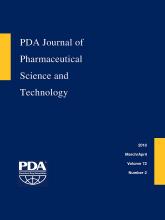Abstract
Sufficient rubber stopper sealing performance throughout the entire sealed product life cycle is essential for maintaining container closure integrity in the parenteral packaging industry. However, prior publications have lacked systematic considerations for the time-dependent influence on sealing performance that results from the viscoelastic characteristics of the rubber stoppers. In this paper, we report results of an effort to study these effects by applying both compression stress relaxation testing and residual seal force testing for time-dependent experimental data collection. These experiments were followed by modeling fit calculations based on the Maxwell-Wiechert theory modified with the Kohlrausch-Williams-Watts stretched exponential function, resulting in a nonlinear, time-dependent sealing force model. By employing both testing evaluations and modeling calculations, an in-depth understanding of the time-dependent effects on rubber stopper sealing force was developed. Both testing and modeling data show good consistency, demonstrating that the sealing force decays exponentially over time and eventually levels off because of the viscoelastic nature of the rubber stoppers. The nonlinearity of stress relaxation derives from the viscoelastic characteristics of the rubber stoppers coupled with the large stopper compression deformation into restrained geometry conditions. The modeling fit with capability to handle actual testing data can be employed as a tool to calculate the compression stress relaxation and residual seal force throughout the entire sealed product life cycle. In addition to being time-dependent, stress relaxation is also experimentally shown to be temperature-dependent. The present work provides a new, integrated methodology framework and some fresh insights to the parenteral packaging industry for practically and proactively considering, designing, setting up, controlling, and managing stopper sealing performance throughout the entire sealed product life cycle.
LAY ABSTRACT: Historical publications in the parenteral packaging industry have lacked systematic considerations for the time-dependent influence on the sealing performance that results from effects of viscoelastic characteristic of the rubber stoppers. This study applied compression stress relaxation testing and residual seal force testing for time-dependent experimental data collection. These experiments were followed by modeling fit calculations based on the Maxwell-Wiechert theory modified with the Kohlrausch-Williams-Watts stretched exponential function, resulting in a nonlinear, time-dependent sealing force model. Experimental and modeling data show good consistency, demonstrating that sealing force decays exponentially over time and eventually levels off. The nonlinearity of stress relaxation derives from the viscoelastic characteristics of the rubber stoppers coupled with the large stopper compression deformation into restrained geometry conditions. In addition to being time-dependent stress relaxation, it is also experimentally shown to be temperature-dependent. The present work provides a new, integrated methodology framework and some fresh insights to the industry for practically and proactively considering, designing, setting up, controlling, and managing of the stopper sealing performance throughout the entire sealed product life cycle.
- Compression stress relaxation (CSR)
- Residual seal force (RSF)
- Container closure system (CCS)
- Container closure integrity (CCI)
- Stopper
- Vial
- Cap
- Seal
- Capping
- Time-dependent
- Temperature-dependent
- Maxwell-Wiechert model
- Kohlrausch-Williams-Watts (KWW) stretched exponential function
- © PDA, Inc. 2018
PDA members receive access to all articles published in the current year and previous volume year. Institutional subscribers received access to all content. Log in below to receive access to this article if you are either of these.
If you are neither or you are a PDA member trying to access an article outside of your membership license, then you must purchase access to this article (below). If you do not have a username or password for JPST, you will be required to create an account prior to purchasing.
Full issue PDFs are for PDA members only.
Note to pda.org users
The PDA and PDA bookstore websites (www.pda.org and www.pda.org/bookstore) are separate websites from the PDA JPST website. When you first join PDA, your initial UserID and Password are sent to HighWirePress to create your PDA JPST account. Subsequent UserrID and Password changes required at the PDA websites will not pass on to PDA JPST and vice versa. If you forget your PDA JPST UserID and/or Password, you can request help to retrieve UserID and reset Password below.






